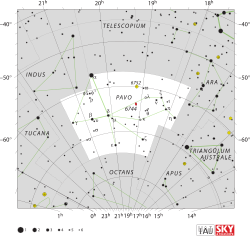Kappa Pavonis
| Kappa Pavonis | |
 | |
| Observationsdata Epok: J2000.0 | |
|---|---|
| Stjärnbild | Påfågeln |
| Rektascension | 18t 56m 57,02788s[1] |
| Deklination | -67° 14′ 00,5831″[2] |
| Skenbar magnitud () | 4,35[3] (3,91-4,78 (V))[4] |
| Stjärntyp | |
| Spektraltyp | F5 - G5 I-II[5] |
| B–V | 0,530 ± 0,020[6] |
| Variabeltyp | Pulserande cepheidvariabel av W Virginis-typ[4] |
| Astrometri | |
| Radialhastighet () | 37,80 ± 0,7[7] km/s |
| Egenrörelse (µ) | RA: -8,46[1] mas/år Dek.: 16,476[1] mas/år |
| Parallax () | 5,57 ± 0,28[8] |
| Avstånd | 590 ± 30 lå (180 ± 9 pc) |
| Absolut magnitud () | -1,99[8] |
| Detaljer | |
| Radie | 19-25[9] R☉ |
| Luminositet | 565[10] L☉ |
| Temperatur | 5 250 - 6 350[9] K |
| Metallicitet | -0,5[10] dex |
| Andra beteckningar | |
| GC 25930, HR 7107, SAO 254413, GCRV 11348, IRAS 18517-6717, SKY# 34936, CD-67 2287, GEN# +1.00174694, 2MASS J18565700-6714005, TD1 23350, CPC 21 4411, GSC 09082-01890, N30 4191, TYC 9082-1890-1, CPD-67 3603, HD 174694, PLX 4354, uvby98 100174694, FK5 3505, HIC 93015, PLX 4354.00, WEB 16107, Gaia DR2 6434564460626657536, HIP 93015, PPM 363676, AAVSO 1846-67[2] | |
Kappa Pavonis (κ Pavonis, förkortat Kappa Pav, κ Pav), som är stjärnans Bayer-beteckning, är en ensam stjärna i den mellersta delen av stjärnbilden Påfågeln. Den har en genomsnittlig skenbar magnitud på +4,35[3] och är synlig för blotta ögat där ljusföroreningar ej förekommer. Baserat på parallaxmätningar i Hipparcos-uppdraget på ca 5,6[8] mas beräknas den befinna sig på ca 590 ljusårs (180 parsek) avstånd från solen.
Egenskaper[redigera | redigera wikitext]
Kappa Pavonis är en gul till vit stjärna som varierar från ljusstark jätte till superjätte av spektralklass F5-G5 I-II.[5] Den har en radie som är ca 19 - 25[9] gånger större än solens och utsänder ca 565[10] gånger mera energi än solen från dess fotosfär vid en effektiv temperatur på 5 300 till 6 400 K.[9]
Kappa Pavonis är en pulserande variabel av Cepheid-typ av underkategorin W Virginis-variabler (CW). Den varierar mellan skenbar magnitud +3,91 och 4,78 med en period av 9,083 dygn.[4] Den är den ljusaste W Virginis-variabeln på himlen.
Se även[redigera | redigera wikitext]
Referenser[redigera | redigera wikitext]
- Den här artikeln är helt eller delvis baserad på material från engelskspråkiga Wikipedia, Kappa Pavonis, 30 april 2019.
Noter[redigera | redigera wikitext]
- ^ [a b c] Van Leeuwen, F. (2007). "Validation of the new Hipparcos reduction". Astronomy and Astrophysics. 474 (2): 653. arXiv:0708.1752. Bibcode:2007A&A...474..653V. doi:10.1051/0004-6361:20078357.
- ^ [a b] ”Basic data: V* Kap Pav – Variable Star of W Vir type” (på engelska). Centre de Données astronomiques de Strasbourg. Arkiverad från originalet den 3 juli 2018. https://web.archive.org/web/20180703075453/http://simbad.u-strasbg.fr/simbad/sim-basic?Ident=Kap+Pav&submit=SIMBAD+search. Läst 3 juli 2018.
- ^ [a b] Feast, Michael W.; Laney, Clifton D.; Kinman, Thomas D.; Van Leeuwen, Floor; Whitelock, Patricia A. (2008). "The luminosities and distance scales of type II Cepheid and RR Lyrae variables". Monthly Notices of the Royal Astronomical Society. 386 (4): 2115. arXiv:0803.0466. Bibcode:2008MNRAS.386.2115F. doi:10.1111/j.1365-2966.2008.13181.x.
- ^ [a b c] ”Kap Pav” (på engelska). The International Variable Star Index. AAVSO – American Association of Variable Star Observers. http://www.aavso.org/vsx/index.php?view=detail.top&oid=25119. Läst 3 juli 2018.
- ^ [a b] Samus, N. N.; Durlevich, O. V.; et al. (2009). "VizieR Online Data Catalog: General Catalogue of Variable Stars (Samus+ 2007-2013)". VizieR On-line Data Catalog: B/gcvs. Originally published in: 2009yCat....102025S. 1. Bibcode:2009yCat....102025S.
- ^ van Leeuwen (2007). ”Hipparcos, the New Reduction” (på engelska). Arkiverad från originalet den 3 juli 2018. https://web.archive.org/web/20180703075419/http://vizier.u-strasbg.fr/viz-bin/VizieR-5?-out.add=.&-source=I%2F311%2Fhip2&HIP=93015. Läst 3 juli 2018.
- ^ Gontcharov, G. A. (2006). "Pulkovo Compilation of Radial Velocities for 35 495 Hipparcos stars in a common system". Astronomy Letters. 32 (11): 759. arXiv:1606.08053. Bibcode:2006AstL...32..759G. doi:10.1134/S1063773706110065.
- ^ [a b c] Benedict, G. Fritz; McArthur, Barbara E.; Feast, Michael W.; Barnes, Thomas G.; Harrison, Thomas E.; Bean, Jacob L.; Menzies, John W.; Chaboyer, Brian; Fossati, Luca; Nesvacil, Nicole; Smith, Horace A.; Kolenberg, Katrien; Laney, C. D.; Kochukhov, Oleg; Nelan, Edmund P.; Shulyak, D. V.; Taylor, Denise; Freedman, Wendy L. (2011). "Distance Scale Zero Points from Galactic RR Lyrae Star Parallaxes". The Astronomical Journal. 142 (6): 187. arXiv:1109.5631. Bibcode:2011AJ....142..187B. doi:10.1088/0004-6256/142/6/187.
- ^ [a b c d] Breitfelder, J.; Kervella, P.; Mérand, A.; Gallenne, A.; Szabados, L.; Anderson, R. I.; Willson, M.; Le Bouquin, J.-B. (2015). "Observational calibration of the projection factor of Cepheids. I. The type II Cepheid κ Pavonis". Astronomy & Astrophysics. 576: A64. arXiv:1503.05176. Bibcode:2015A&A...576A..64B. doi:10.1051/0004-6361/201425171.
- ^ [a b c] Balog, Z.; Vinko, J.; Kaszas, G. (1997). "Baade-Wesselink Radius Determination of Type II Cepheids". Astronomical Journal. 113: 1833. Bibcode:1997AJ....113.1833B. doi:10.1086/118394.
Externa länkar[redigera | redigera wikitext]
- https://web.archive.org/web/20190430151133/https://www.universeguide.com/star/kappapavonis
- https://web.archive.org/web/20161104163857/http://stars.astro.illinois.edu/sow/kappapav.html





